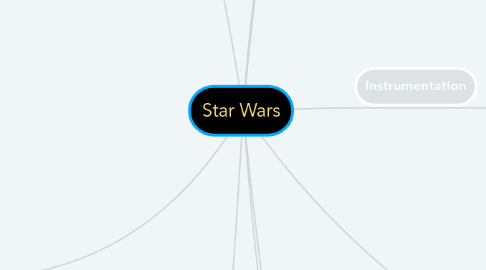
1. Melody
1.1. bars 1-3
1.1.1. based on Bb chord with added 4ths (Eb) and 7ths (Ab)
1.1.2. rapid repeated notes on Bb tonic
1.1.3. arpeggio-like triplets based around 4th leaps, suggesting power and strength
1.1.4. notes F, Bb and Eb are prominent (Ab in horn and tuba)
1.2. main theme (rebel blockade runner)
1.2.1. 4 note chord (F, Bb, Eb, Ab) used in the harmonisation
1.2.2. 4th and 7th intervals are important
1.2.3. ABA - made of two ideas
1.2.3.1. A
1.2.3.1.1. 4 bar idea repeated to form 8 bar phrase
1.2.3.1.2. balance of conjunct and disjunct
1.2.3.1.3. diatonic in Bb
1.2.3.1.4. perfect rising 5th (Bb to F) gives a heroic feel, appropriate for Luke Skywalker's character
1.2.3.1.5. bars 5 & 6 are identicle
1.2.3.1.6. leap of minor 7th in bar 5
1.2.3.1.7. falling 4th in bar 5, inversion of bar 4
1.2.3.1.8. bars 5-7 have the same rhythm
1.2.3.1.9. triplet quavers create mood of excitement
1.2.3.1.10. tied minim across beats 2 & 3 creates tension
1.2.3.2. B
1.2.3.2.1. 4 bar idea repeated and slightly altered
1.2.3.2.2. anacrusis on last beat of bar 11
1.2.3.2.3. rising 6th in bars 12 & 14
1.2.3.2.4. triplet figure in bar 13 remind listener of A
1.2.3.2.5. on repeat (18 & 19), altered ending with downward Bb minor melodic scale
1.2.3.2.6. contrary motion (18)
1.2.3.2.7. piccolo solo (36-39) contrasts with A, quieter and lighter
1.2.3.2.8. rising and falling minor 3rd in chords (51-60)
1.2.3.2.9. sequence in string parts (32)
2. Tonality
2.1. Bb for first 29 bars
2.2. bar 30 - tonality is less clear
2.3. 41-60 - more complex chords, dissonance, almost atonal
2.4. 42 onwards - often based on C on bass pedal
2.5. 51-60 - combines bitonality
3. Harmony
3.1. opening tonic of Bb major is deceptive, rarely uses functional harmony
3.2. quartal harmony used at the start
3.3. unrelated chords often used (Bb followed by F)
3.4. added notes often used, some extensions of the chord (B main theme)
3.5. added chromatic notes (outside tonic key) C major chords create unstable feel to harmony
3.5.1. accentuated by using dissonant/chromatic chords in link section (33-36)
3.6. brutality of empire reflected with unison cluster chords in march section and through melodic tritone (G-Db) bar 44
3.7. final section uses bitonality, repetitive tonic pedal in C minor against rebels theme in Db major
3.8. imperfect cadence at the end of A main theme (7)
3.9. added 6th chords (12)
3.10. neapolitan chords (53-56) on flattened supertonic
4. Instrumentation
4.1. traditional symphonic/romantic treatment of orchestra
4.1.1. doubling of parts
4.1.2. thickly scored with few solos and lighter textures
4.1.3. avoids electronic effects/synthesisers
4.2. full symphony orchestra
4.2.1. strings
4.2.2. piano/celeste, harp
4.2.3. timpani, triangle, snare drum, tam tam, cymbals, glockenspiel, vibraphone
4.2.4. 4 horns, 3 trumpets, 3 trombones, tuba
4.2.5. 3 flutes, 1 piccolo, 2 oboes, 2 clarinets, bass clarinet, 2 bassoons
5. Structure
5.1. unified in structure with and expressive qualities
5.2. some melodic motifs, rhythms and harmony
5.3. starts with introductory 3 bar fanfare followed by main theme
5.4. main theme in ternary structure in regular 4 bar phrases
5.5. remainder of extract takes place with on screen action so it has less musical structure
5.6. link section follows and leads into Rebel blockade runner theme on piccolo
5.7. another short link into march section
5.8. finishes with codetta
6. Rhythm
6.1. military feel emphasised by martial rhythms
6.2. triplets are widespread and typical of fanfares
6.3. main theme accompanied by syncopated block chords
6.4. final section with one bar ostinato is reminiscent of Mars
6.5. repeated notes and triplets in fanfre create expectation
6.6. rhythmic feeling of main theme - strong quadruple pulse with triplets
6.7. bar 33 onwards - rhythmic feel changes, pulse is less obvious
6.8. homorhythmic chords (44-50) create drama by mixing quavers, triplet quaver and crotchets with rests, tempo slows to increase effect
7. Tempo
7.1. fast for opening to match the action genre
7.2. bar 51 - music is very fast to end the extract
8. Metre
8.1. 4/4 reflects military nature
8.2. changes to 3/4 (44)
9. Tempo
9.1. mostly homophonic (melody and accompaniment)
9.2. often doubled octaves
9.3. main theme mostly accompanied with block/articulated chords and arpeggios
9.4. variety of pedal textures
9.4.1. inverted tonic pedal in intro and main theme
9.4.2. dominant pedal (12-15)
9.4.3. ostinato textures in strings and bass (51-60)
